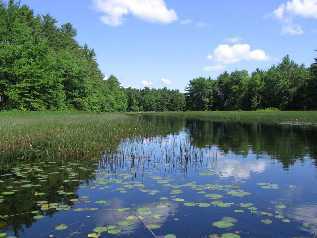Home → Water Quality → Monitoring & Reporting → Biomonitoring → Sampling & Analysis → Wetland Algae
 Algae Sampling in Wetlands
Algae Sampling in Wetlands
Site locations & rationale
The Biological Monitoring Program has sampled algae from sites in freshwater wetlands distributed throughout the State of Maine since 1998. Sampling occurs during June and early July. Wetland sampling sites are chosen to represent a gradient of human disturbance. Site conditions range from reference sites nearly unaffected by human activity to severely degraded sites. Reference wetlands are chosen to provide a range of wetland types and geographic regions. Algal samples in human-impacted wetlands are compared to those from reference wetlands of similar type and geography to assess the degree of degradation occurring at impacted sites.
Sampling methods
Water column Phytoplankton samples are taken using a long-handled dipper that collects water samples just below the water surface. Water samples from multiple areas of the wetland are combined into a single sample. The samples are used for quantitative analysis of phytoplankton abundance and species composition. Chlorophyll a is also analyzed in these samples as an indicator of algal biomass.
Plant stems Epiphytic algae that grow on plant stems are collected using garden shears to clip the plant stems below the water line. The plant stems are placed into a plastic whirlpak bag and tap water is added. The stems are then massaged through the bag to remove attached algae, rinsed with additional water and discarded. The surface area of each plant stem is calculated from field measurements to obtain a quantitative sample.
Data analysis
The algae in both the water column and plant stem samples are identified to the lowest taxonomic level possible, usually species or genus. This information is used to calculate information such as relative abundances and generic richness of pollution-sensitive taxa that are used to assess wetland water quality. Chlorophyll a is also analyzed from water column samples as an indicator of algal biomass.
The Biological Monitoring Program is currently working to develop thresholds and criteria for incremental levels of biological impairment based on wetland algae. The program is also exploring various statistical methods to summarize algal data in wetland regulatory and management decisions, to develop wetland water quality standards, and to report on wetland condition as required under the Federal Clean Water Act.